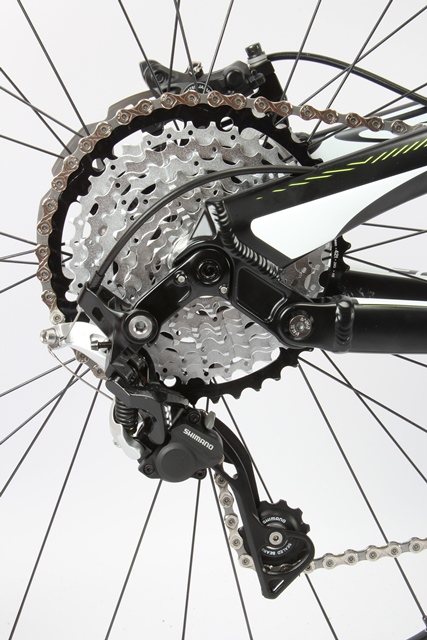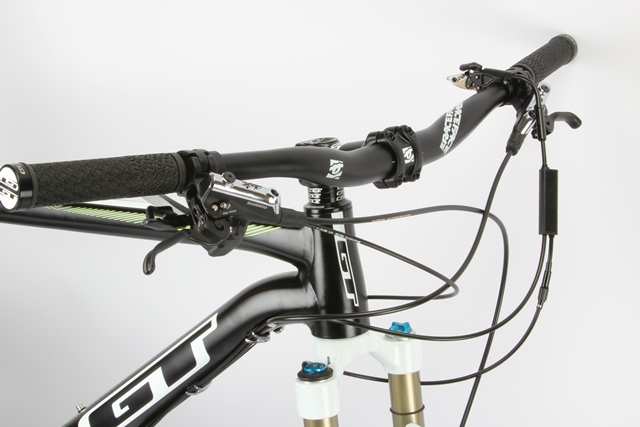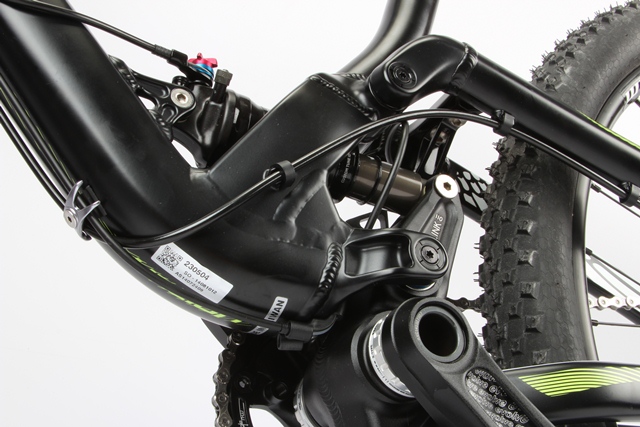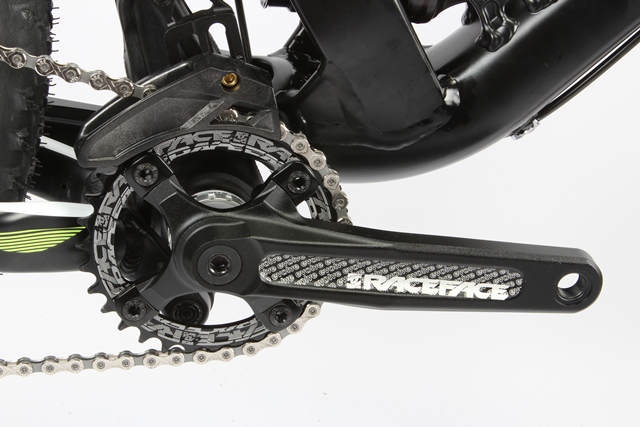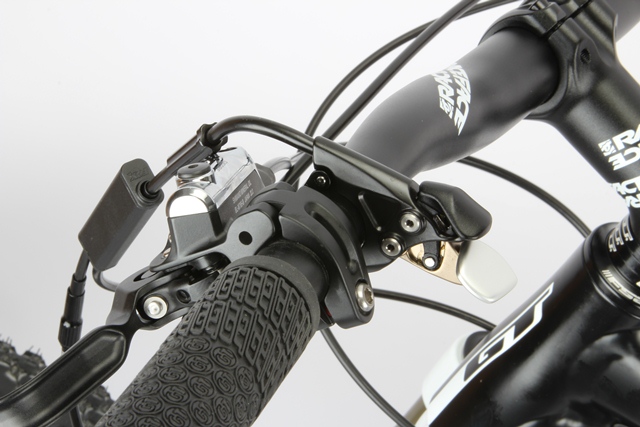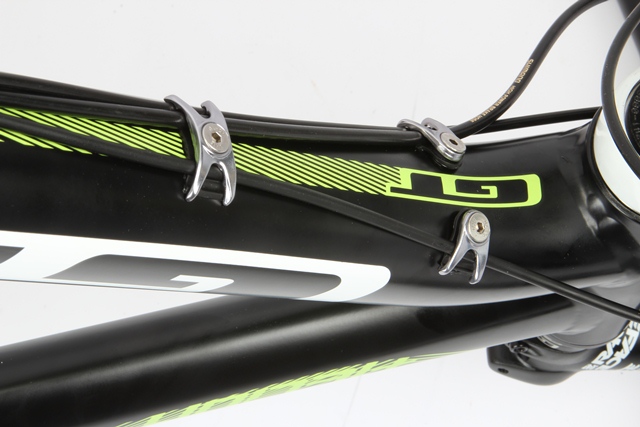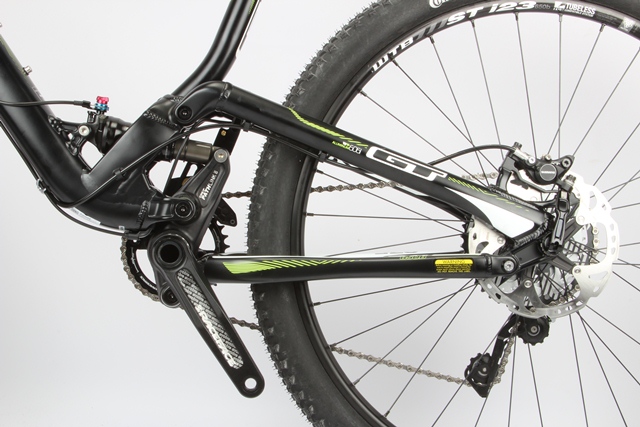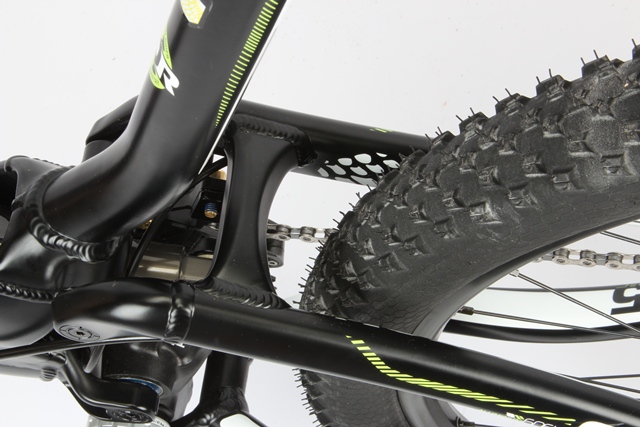GT Helion Pro
 GTs new Helion is pitched as an XC bike that provides a balance between fun and efficient pedalling, so is it an XC racer or an all-round trail bike? There was a time, not all that long ago, when bikes with short travel and small wheels dominated the crosscountry race scene. They were swift and incredibly agile beasts, and when they weren’t on the race track, many of them served double duty as fast trail bikes—especially in areas where the trails were tight but not overly steep or technically demanding.
GTs new Helion is pitched as an XC bike that provides a balance between fun and efficient pedalling, so is it an XC racer or an all-round trail bike? There was a time, not all that long ago, when bikes with short travel and small wheels dominated the crosscountry race scene. They were swift and incredibly agile beasts, and when they weren’t on the race track, many of them served double duty as fast trail bikes—especially in areas where the trails were tight but not overly steep or technically demanding.
Then along came the 29er wheel with its superior rollover and momentum carrying abilities, and for a time it seemed that the nimble XC bike had gone the way of the dodo— the scalpel had been abandoned in favour of the broadsword. Still, somewhere in the back of our collective MTB psyche was a silent yearning for the return of the XC whippet. And now we’re seeing a small but growing number of bikes that answer this call, and the GT Helion is amongst them.
Everything expands with time it seems, so this modern XC bike now sports 110mm of travel at both ends and 27.5- inch wheels, but nevertheless the Helion harks back to the fast accelerating, short travel bikes of five or more years back. Available in three carbon and three aluminium models ranging from $2,499 up to $6,899, our Helion Pro test bike is the top spec of the aluminium bikes, and it retails for $3,999. Cockpit and cranks are from Race Face, Shimano XT provides the stop and go gear, the wheels are tubeless ready WTB i23 rims laced to SLX hubs, and Fox supplies the bouncy bits from its Factory CTD range. It’s all very functional gear, and whilst not uber-light there’s no need to upgrade any of it until it wears out.
All models will fit a water bottle within the front triangle, which is an absolute must for an XC bike. The subtly shaped tubes and compact rear triangle give the Helion a clean and purposeful stance, and it’s certainly stiff enough to transfer power to the rear wheel or to track straight through the rocks. The amount of metal required for that stiffness no doubt contributes to the 3,100g frame and shock weight, and total weight of 12.97kg without pedals. While it’s too heavy to be truly competitive XC race bike, it is reasonable enough for a trail bike. Ditching the tubes from the Continental X-King tyres is the easiest way to lighten things up a bit, but it’s still not going to blow away in a stiff breeze, or probably a cyclone for that matter.
WHO THE HELION AM I?
In terms of spec, the Helion seems to be suffering from a slight personality crisis. The 740mm wide handlebar, thru-axles at both ends, and very low bottom bracket say trail bike, whilst the 80mm long stem, 69.5-degree head angle and remote lockout for both the fork and shock say XC bike. The X-King tyres probably have a foot in both camps, as does the top mounted chain guide and 42-tooth extender cog that is supplied with the bike. With the 42 cog fitted you get a really good 1X gear range but gear spacing and shift quality suffers a bit (as is generally the case with these adaptors).
Big 180mm brake rotors probably rate as overkill for the intended use and will quickly overwhelm the traction offered by the XC tyres— especially on the rear. Whether you’re classing it as XC or trail, the lack of any dropper post routing is a serious omission; even some XC pros are running dropper posts on technical courses these days. Most of these things are easily addressed at a shop level for little or no expense; swapping out a few components would easily give the Helion a different character. For our steep and rough (and as it happened, damp) local terrain we swapped the stem for a 60mm unit, dropped the inner tubes and swapped to a more aggressive front tyre; there’s certainly wiggle room either way depending on your preferences.
Regardless of which way you want to go, one thing that doesn’t need changing is the AOS suspension. Released a few years back now on the Sensor and Force ranges, it’s the latest iteration of the floating bottom bracket design used by GT and its sister brand Mongoose for over a decade. The Helion sees further refinement to the construction, with the front pivots all using expanding collet-type hardware instead of the pinch bolt arrangement on the other bikes in GT’s range.
This system features a very high main pivot, which allows the rear wheel to move back and up following the path of least resistance over obstacles. At the same time, because the bottom bracket moves rearward slightly as the suspension compresses, there isn’t the massive pedal kickback and suspension stiffening you’d normally associate with such a high main pivot point. Some riders may notice the bottom bracket movement for the first few minutes, but the sensation quickly vanishes and is replaced by wonderment at how a bike can feel so smooth over square impacts and yet still pedal almost like a hardtail.
And pedal it does; despite having access to the ‘trail’ and ‘climb’ modes on both suspension units at the press of your left thumb, after a bit of early experimentation we left the shock ‘fully open’ for the rest of the test period. If you spend a lot of time on gravel roads or trying to remove every millisecond from your lap times, you might find the more heavily damped suspensions modes of some value, but for everything else they’re all but unnecessary. In wet conditions we noticed a bit of mud collecting on the shock shaft, so judicious cleaning will be required if your trails are often damp.
Not needing to use the suspension remote is a good thing, as with one lever operating two sets of cables, the thumb force required is considerable. Overall the cable routing is a bit of a debacle. Yes, it looks clean and neat from a distance, but the kinks and twists required to get cables from under the down tube to the shock and derailleur create a friction nightmare. Why GT didn’t run the cables on the top of the down tube and thence along the top of the seat stays will remain, in my mind at least, one of the great mysteries of the modern world. With a small amount of fettling this could easily be done at home. And whilst I’m quibbling, the seat tube on our test bike had a burr or weld splatter inside which gouged at the seatpost every time the saddle height was adjusted. It was significant enough that we would have expected their QC to pick up on it but it’s still likely to be a one-off oversight. In any case it was easy enough the fix with some abrasive paper.
HELION ON WHEELS
As you'd expect with any good cross-country bike, the Helion makes you want to get out of the saddle and hammer the pedals way more often than is needed. Maybe it’s because staying seated isn’t armchair plush, or maybe it’s because your efforts net a more tangible reward. Whatever the case, the Helion makes you want to ride fast and there's a direct connection between stomping the pedals and surging forward. It doesn’t feel armchair plush, but rather it’s sports car stiff; it sucks up the smaller bumps relatively easily, and whilst bigger impacts are transferred to the rider, it’s more a case of feeling exactly what’s happening under your tyres rather than having your fillings shaken loose.
The second thing I noticed about the Helion was how much you ride it from the front of the bike, rather than the centre or rear. In this sense it feels almost like an XC hardtail; you spin the cranks and point the front end where you want it to go, driving through the front suspension and just letting the rear wheel follow along however it chooses. That’s not to say that it can’t hold a straight line or that the back end isn’t relatively supple, because it can, and it is. When required, you can hang back and over the rear wheel to negotiate more treacherous terrain, and the AOS suspension has a strongly progressive end stroke that makes it feel like you’ve got more travel on tap than the 110mm on the spec sheet.
As mentioned previously, the rear suspension deals with square impacts particularly well; stepped and choppy climbs become a challenge to be sought out rather than avoided. If you can keep the pedals spinning and the rear tyre weighted it’ll climb almost anything, and there’s very little kickback through the pedals to disrupt your rhythm. The 438mm chainstays also strike a good balance between combating that feeling of ‘looping out’ on steep climbs, without cornering like a barge on tight switchbacks. The caveat here is the low bottom bracket; it’s a belly-scraping 325mm without sag, so timing your pedal strokes through obstacles becomes vitally important.
The flipside of the poor pedal clearance is exceptional stability through high-speed turns—the Helion helps you to carve corners like a pro. Numerous times it had me pushing hard enough to reveal flex in the wheels, and the tyres were squirming sideways on the rims when running 25psi in them. The Helion’s enthusiasm for gravity-induced speed also got me into trouble on more than one occasion. It’ll lull you into a false sense of security on moderate descents, then if you’re unwary, the steep head angle will slap you around when you hit step-downs or rock gardens.
All of these riding traits again highlight the ‘jack of all trades, master of none’ character of the Helion. That’s not to say I haven’t enjoyed riding it; on the contrary, after getting into the XC character after the first few rides, I thoroughly enjoyed razzing it through twisty trails and covering distances at a speedy clip, well speedy for me in any case! If I lived and rode somewhere with fewer pedal obstacles and less steepness (Canberra or Forrest for example), I think it’d be a great do-it-all bike. In these situations the low bottom bracket and steep head angle would be a huge asset, rather than a sometimes liability.
But I think it could be even more versatile with a few minor and inexpensive tweaks, so here’s my two-cents worth. Remove the largely unrequired suspension remote, put on a 50 or 60mm stem and get the fork adjusted to provide 120mm of travel. The stock fork is basically a Float 120 that’s had the travel restricted. Bumping it back up by 10mm end is unlikely to have any affect on a frame that’s as robust and overbuilt as the Helion. For the final piece of the puzzle, and if you like fast corners and descents, add a dropper post with a few zip ties to secure the remote cable.
You’d retain the snappy acceleration and connected trail feel of the rear suspension, add a few well needed millimetres of pedal clearance and lose around half a degree off the head angle. The resulting ‘Helion+’ will give up next to nothing in smooth ground speed, will still have sharp handling, but be more stable on rough descents and slightly less prone to pedal strikes on rough climbs.
Of course you could more clearly define its XC nature with a few subtle tweaks (such as swapping out the big brake rotors for lighter 160mm units) but at the end of the day the Helion Pro’s frame will always be on the weighty side for competitive XC capers. It’s right on the money for sport level XC racing, but if you’re racing sport category you’re doing it for fun, and I’ll stick my neck out and say the previously mentioned setup will be more fun to ride anywhere, anytime.
As it stands, GT’s new Helion Pro, whilst not truly an XC race bike, offers riders the chance to rediscover the fun of a fast and nimble trail bike. Think of it as a Golf GTI rather than a Mercedes F1. It’s got great suspension and quality components, and with a few tweaks it could easily be the only XC/trail bike you need.
Thumbs Up
• Great pedalling and responsive
• Effective suspension
• Stiff and robust
Thumbs Down
• Weighty frame
• No remote dropper routing
• Spaghetti nightmare Cabling
Specifications
Frame: 6061-T6 Hydroformed Alloy
Shock: Fox Float CTD Remote 110mm Travel
Fork: Fox Float Fit CTD Remote 110mm Travel
Headset: Orbit Tapered
Handlebars: Race Face Ride Low Rise 740mm
Stem: Race Face Ride 80mm
Shifter: Shimano XT
Front Derailleur: e.Thirteen XCX+ Guide
Rear Derailleur: Shimano XT Shadow Plus
Cassette: XT 11/36 (plus optional e.Thirteen 42T cog)
Chain: KMC X10
Cranks: Race Face Evolve w/32T Narrow Wide
Bottom Bracket: Race Face
Pedals: N/A
Brakes: Shimano XT
Rims: WTB STi23 Tubeless
Hubs: All Terra Alloy Centre Lock
Spokes: DT Competition
Tyres: Continental X-King 2.2
Saddle: Fizik Tundra 2
Seatpost: Easton EA70
Weight: 12.97kg without pedals (Large frame 3,100g)
Available Sizes: S, M, L (tested) & XL
Price: $3,999
Distributor: Monza Imports www.gtbicycles.com


 GTs new Helion is pitched as an XC bike that provides a balance between fun and efficient pedalling, so is it an XC racer or an all-round trail bike? There was a time, not all that long ago, when bikes with short travel and small wheels dominated the crosscountry race scene. They were swift and incredibly agile beasts, and when they weren’t on the race track, many of them served double duty as fast trail bikes—especially in areas where the trails were tight but not overly steep or technically demanding.
GTs new Helion is pitched as an XC bike that provides a balance between fun and efficient pedalling, so is it an XC racer or an all-round trail bike? There was a time, not all that long ago, when bikes with short travel and small wheels dominated the crosscountry race scene. They were swift and incredibly agile beasts, and when they weren’t on the race track, many of them served double duty as fast trail bikes—especially in areas where the trails were tight but not overly steep or technically demanding.